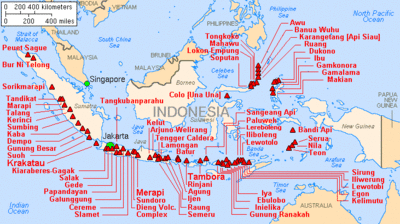Volcanology of Indonesia

Indonesia is a volcanically active country, containing numerous major volcanoes. It has 130 active volcanoes that are part of the Pacific Ring of Fire and has suffered the highest numbers of eruptions producing fatalities, damage to arable land, debris flows, tsunamis, domes, and pyroclastic flows. Indonesia's most active volcanoes are Kelut and Mount Merapi on the island of Java. The country's volcanism is due to the subduction of the Indo-Australian Plate.
The most severe eruptions on earth in historical time took place in Indonesia. The giant eruption of Mount Tambora in 1815, the largest known eruption of the world during historical times and had such a large effect on the climate that for example Europe was to experience 1816 as the year without summer. In 1883, the catastrophic eruption of Krakatoa engraved itself deeply into the group memory of mankind . The eruption of Krakatoa was followed by serious tsunamis that killed about 30–40,000 people .